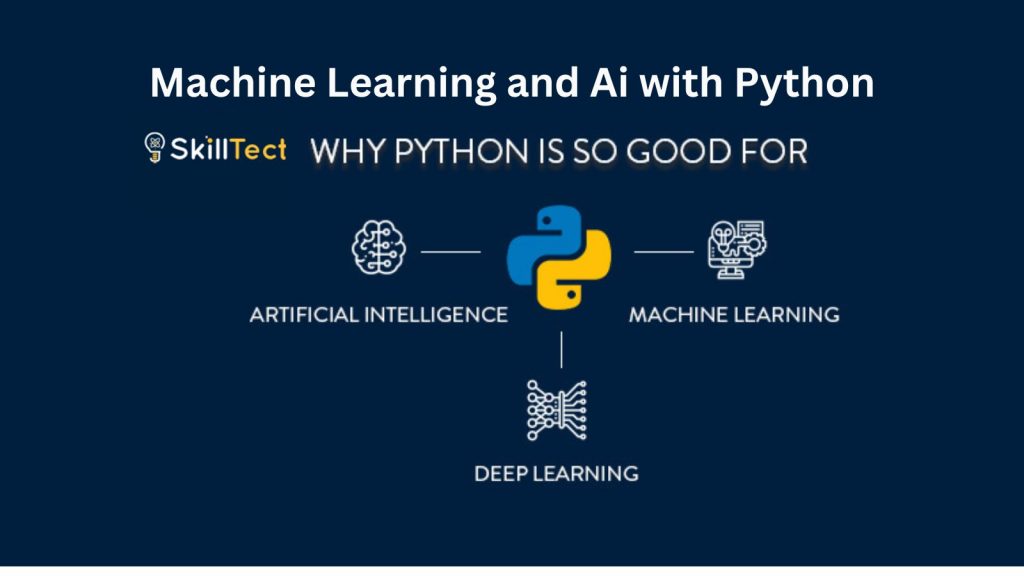Machine Learning and AI with Python – Machine learning (ML) has revolutionized various industries, offering the power to extract insights, automate processes, and predict outcomes. Python, with its robust libraries and simplicity, is the go-to language for building ML models. In this article, we’ll explore different types of ML algorithms, understand linear classification methods, and implement classification techniques in Python. We will also evaluate regression models using appropriate metrics.

What Are the Different Types of Machine Learning Algorithms?
Machine learning algorithms can be broadly classified into three categories:
Reinforcement Learning: The model learns to make decisions by interacting with an environment, and receiving rewards or penalties. It is used in:
- Game playing: Training AI to play games like chess.
- Robotics: Enabling robots to learn tasks autonomously.
Supervised Learning: In this approach, the model is trained on labelled data, meaning the output is known. Examples include:
- Regression: Predicting continuous values (e.g., house prices).
- Classification: Predicting discrete values or categories (e.g., spam vs. non-spam emails).
Unsupervised Learning: Here, the model finds patterns in the data without any labelled outputs. Examples include:
- Clustering: Grouping data points based on similarity (e.g., customer segmentation).
- Association: Discovering relationships between variables (e.g., market basket analysis).
How Do Linear Classification Methods Differ?
Linear classification methods are used to predict categorical outcomes, such as yes/no decisions. Three common techniques include:
Logistic Regression
- It uses a logistic function to model binary outcomes.
- Suitable for binary classification problems like determining whether an email is spam.
- Multiclass Logistic Regression (Softmax regression) extends this to handle multiple classes (e.g., predicting the type of fruit).
Support Vector Machines (SVM)
- SVMs aim to find a hyperplane that best separates data points into different classes.
- Effective for high-dimensional spaces and complex datasets.
- Suitable when classes are not linearly separable as it uses kernel functions to project data into higher dimensions.
Multiclass Classification
- Extends binary classification algorithms (e.g., logistic regression) to handle multiple categories.
- Common methods include the one-vs-all approach, where separate binary classifiers are trained for each class.
- Logistic Regression is simple and interpretable but may struggle with complex, non-linearly separable data.
- SVM can handle non-linear relationships using kernels, making it versatile but computationally intensive.
- Multiclass Classification methods, while adaptable, can be sensitive to class imbalance.
How Can You Implement Various Classification Techniques in Python?
Python offers several libraries like Scikit-learn for implementing classification techniques. Below are implementations for K-Nearest Neighbors (KNN), Decision Trees, and Regression Trees.
# Import necessary libraries
from sklearn.datasets import load_iris
from sklearn.model_selection import train_test_split
from sklearn.neighbors import KNeighborsClassifier
from sklearn.tree import DecisionTreeClassifier
from sklearn import metrics
# Load dataset
data = load_iris()
X = data.data
y = data.target
# Split the dataset into training and testing sets
X_train, X_test, y_train, y_test = train_test_split(X, y, test_size=0.3, random_state=42)
# K-Nearest Neighbors (KNN)
knn = KNeighborsClassifier(n_neighbors=5)
knn.fit(X_train, y_train)
knn_pred = knn.predict(X_test)
# Decision Tree Classifier
tree = DecisionTreeClassifier(random_state=42)
tree.fit(X_train, y_train)
tree_pred = tree.predict(X_test)
# Evaluate the models
print("KNN Accuracy:", metrics.accuracy_score(y_test, knn_pred))
print("Decision Tree Accuracy:", metrics.accuracy_score(y_test, tree_pred))Explanation:
- K-Nearest Neighbors (KNN): This algorithm classifies a data point based on the majority label of its nearest neighbours. It’s intuitive but may be sensitive to outliers.
- Decision Trees: These create a tree-like structure for making decisions. They are easy to interpret but can overfit if not pruned properly.
How to Evaluate Regression Models Using Python?
Evaluating regression models requires measuring how well the model’s predictions align with actual values. We’ll explore linear, non-linear, and multiple regression models using metrics like Mean Absolute Error (MAE), Mean Squared Error (MSE), and R-squared.
# Import necessary libraries
import numpy as np
from sklearn.linear_model import LinearRegression
from sklearn.metrics import mean_absolute_error, mean_squared_error, r2_score
# Simulate a dataset
np.random.seed(0)
X = 2 * np.random.rand(100, 1)
y = 4 + 3 * X + np.random.randn(100, 1)
# Train the model
lin_reg = LinearRegression()
lin_reg.fit(X, y)
y_pred = lin_reg.predict(X)
# Evaluate the model
mae = mean_absolute_error(y, y_pred)
mse = mean_squared_error(y, y_pred)
r2 = r2_score(y, y_pred)
print(f"MAE: {mae}")
print(f"MSE: {mse}")
print(f"R-squared: {r2}")Explanation:
- Mean Absolute Error (MAE): Measures the average absolute difference between actual and predicted values. Lower values indicate better performance.
- Mean Squared Error (MSE): Gives higher weight to large errors, useful for penalizing significant deviations.
- R-squared: Represents the proportion of variance in the dependent variable explained by the model. Closer to 1 indicates a better fit.
Regression Models:
- Simple Linear Regression: Suitable when there is a linear relationship between the predictor and outcome variable.
- Non-Linear Regression: Applied when the relationship is not linear; techniques like polynomial regression can model such data.
- Multiple Regression: Useful when predicting an outcome using multiple predictors.
Conclusion Machine Learning and AI with Python
Machine learning offers powerful tools for predictive modelling, and Python provides a user-friendly platform to implement these algorithms. By understanding different types of ML algorithms, choosing appropriate classification methods, and implementing and evaluating regression techniques, you can effectively leverage Python for machine learning projects.
Related More:
What is Generative AI? A Deep Dive into Its Core
1. What are the different types of machine learning algorithms?
Supervised Learning: Uses labelled data for predictions (e.g., regression, classification).
Unsupervised Learning: Identifies patterns without labelled outputs (e.g., clustering, association).
Reinforcement Learning: Learned by interacting with an environment and receiving rewards.
2. What is the difference between logistic regression, SVM, and multiclass classification?
Logistic Regression: Best for binary classification but extendable to multiclass problems (Softmax).
Support Vector Machines (SVM): Effective for high-dimensional and non-linearly separable data using kernels.
Multiclass Classification: Adapts binary classifiers to handle multiple categories (e.g., one-vs-all method).
3. How can I implement K-Nearest Neighbors (KNN) and decision trees in Python?
Use Python libraries like Scikit-learn. KNN classifies based on the nearest neighbours’ majority label, while decision trees use tree-like structures for decision-making.

Leave a Reply